Holcomb Valley Gold Discovery
L. Burr Belden*When the word California and gold are linked one instinctively thinks of the Mother Load district in the Sierra; but there have been literally scores of major gold discoveries in this state all the way from the mountains of San Diego County to the Oregon border. Gold was first found in what is now San Bernardino County in 1849 by overland travelers from Salt Lake, and again nearly ten years later in Bear Valley. The Bear Valley diggings never proved very profitable, but they are important because among the hardy miners who packed their foodstuffs and tools up steep canyon trails to reach these remote diggings there was a young man who was soon to find a far richer gold field.
This young miner was William Francis Holcomb, and his discovery received the appropriate name Holcomb Valley. Holcomb Valley’s principal town Belleville, during the Civil war years, ranked second or third in population for Southern California. In addition to being a prospector Bill Holcomb was a noted hunter, and because of the accuracy of his rifle Holcomb was chosen to supply meat for the Bear Valley miners. It was on one of these hunting trips that Holcomb crossed over the mountains at the south side of Bear Valley and shot bears in the little valley beyond. After shooting three grizzlies in as many attempts Holcomb was chagrined when his fourth shot only wounded a bear. It ran off leaving a trail of blood. The next day Holcomb and a companion returned to track the wounded grizzly which they found dead a short distance away.
Ever the prospector, Holcomb paused to chip at a piece of soft rock, which to his surprise contained sizable chunks of gold. He staked out a claim, butchered the bear, and returned to camp jubilant over his discovery.
Files in the office of County Recorder Ted R. Carpenter show that on May 5, 1860, William Francis Holcomb and Ben Ware located five gold claims in Holcomb Valley, five miles north of Bear Valley. That was the start of the Holcomb Valley gold rush.
Holcomb, a native of Indiana, had come to California at the height of the gold rush. His party had encountered more than the usual hardships enroute, losing both wagons and oxen. He reached California on foot. After unprofitable attempts at mining in the High Sierra and later in the Kern River field Holcomb and a companion Jack Martin, reached Los Angeles. There they heard of the Bear Valley diggings near San Bernardino. Holcomb and Martin set out determined to make one more try at mining. All the way from Los Angeles they inquired about Bear Valley, but none they asked had heard of the place. At Lytle Creek they stopped at George Lord’s ranch. George told them that there was such a place as Bear Valley and that if they ascended the Santa Ana River Canyon they would find it. Near the mouth of the Santa Ana they encountered F.M. (Mack) Van Luven who had helped outfit several miners for the rough trail. Holcomb and Martin had to force their horses through deep snow to reach the Bear Valley diggings which were at Converse Flats. They found a discouraged group of diggers, and already Bear Valley had been dubbed “Starvation Flats”. Fortunately, soon after Holcomb’s arrival one of the miners panned some earth from under the pine trees a few hundred feet up the slope. The hillside proved for a time a comparative bonanza and probably saved the Bear Valley diggings from abandonment prior to the Holcomb Valley discovery.
Word that the Bear Valley diggings had petered out had already reached San Bernardino when one day the miners chipped in and sent Martin to town for flour. Martin bought his flour at the Meyerstein store. His paying for it with gold dust started half the men in San Bernardino for the diggings, which then included the even richer sand and shale’s of Holcomb Valley. In July and August a real gold rush was on in the Holcomb Valley. In September, Sidney Waite, who had been mining in Bear Valley since March moved over to Arrastre Creek and started mining on quartz ledges.
Winter reduced the miners to short rations. Spring not only brought the bear out of hibernation but also the biggest gold rush southern California had seen.
The Bear Valley diggings were practically deserted as numerous rich strikes were made up and down Holcomb Valley where one had only to scratch the surface to pan out a good day’s wages. These miners referred to their new claims as being in “The Valley of Holcomb”. The incomplete surveys of the period did not include this new valley much less give it a name. As location notices flooded the recorder’s office the place named “Holcomb Valley” was soon written in large letters on San Bernardino county geography.
The fame of the new gold region spread far more rapidly than one might expect in the day of slow transportation and just as slow communication. Not even the steep pack trail up Santa Ana canyon deterred the gold hunters of 1860. Van Luven’s ranch near canyon mouth was passed by three or four parties of gold seekers daily. With the miners came the camp followers of all description intent on making a fast dollar. Soon the sprawling town of Belleville boasted a motley collection of saloons and dance halls as well as stores and a couple of blacksmith shops. Clustered around were the cabins of miners, the first ones built with no thought of parallel streets. Most of the cabins were of logs with two bunk beds hung on the wall. In addition to a considerable number of genuine Confederate sympathizers it is said that the cause of secession drew both lip and gun service from many in Holcomb Valley who were happy to take any stand that gave an excuse to oppose constituted authority. The miners didn’t welcome this ill-assorted group which their gold attracted. Claim jumping was common, but still the living juniper at Arrastre Flats give mute evidence that the honest miners often succeeded in maintaining their legitimate claims. A colorful sidelighting on the time was found in a long preserved notice which reads “Joe Brown takes his ground. Jumpers will be shot.”
It was not unusual either for a miner to sight someone nearer his claim than he considered necessary and shoot without asking questions. If by chance the shot proved fatal the common defense would be that the victim had been mistaken for someone else. Law and order had no easy path in those days. No one asked a man’s name and the early records of Belleville township are filled with such nicknames as Greek George, Red River Jake, Hard Rock Hank, Charlie the Chink, and others which successfully hid the identity of the individual.
By the fall of 1861 Holcomb Valley had become something of an indefinite term applied to a number of adjoining valleys. Rich placer diggings were found farther down the creek in what is now known as lower Holcomb Valley. Upstream, Arrastre Flats was popular with the hard rock or quartz miners. There was a placer gold in paying quantity along Arrastre creek. An early recorded sale notes that Sidney Waite disposed of Arrastre creek claims through Dr. David Noble Smith, founder of the first Arrowhead Springs sanitarium, and his partner Horace Rolfe, the latter an early superior court judge.
Waite then moved to Van Dusen Flats where his location notices served to start another extensive field of placer operation. Later, Waite became the publisher of a pioneer San Bernardino newspaper. It remained for a miner named Elias Jackson Baldwin to first stake claims in Van Dusen canyon and to give the region a nationwide reputation. He was the “Lucky” Baldwin, later of Santa Ana, who developed the Gold Hill mine with it’s 100 stamp mill. Near Gold Mountain rose the town of Doble. Also nearby was a town that existed only on paper in an early lot-selling scheme whose recorded maps are spelled both as “Bairsdtown” and “Beardstown”.
When the Holcomb Valley region began numbering it’s residents in the thousands the steep and narrow trail up Santa Ana canyon to Bear Valley and thence north to Holcomb Valley either via Van Dusen or Polique canyon was far from adequate as a supply route. Typical of the period the miners banded together and hired a town blacksmith, Jed Van Dusen, to build a road. Van Dusen agreed to build the road for $1,500. A subscription list was started with Holcomb and his partners heading it with the largest contribution. The Van Dusen road ran to the west and to the northwest, first along the side of the mountain past Garvey’s Green Lead mine then dropped down the canyon by Coxey’s ranch and Rock Springs. From Rock Springs it crossed the desert for 12 miles to the site of Hesperia, where it turned south to connect with the terminus of John Brown’s toll road through Cajon Pass.
Even before Van Dusen’s road had been completed, wheeled vehicles began entering Holcomb Valley piled high with lumber, merchandise, and provisions.
Belleville, the town named for Van Dusen’s daughter Belle, was considerably larger than San Bernardino and it was not long before some of its residents decided it should become the county seat. An election was held on September 4, 1861. Research indicates that in all probability a majority of the county voters chose Belleville over San Bernardino; but the official returns, which are fragmentary, do not so indicate. These official returns, by the way, indicate that the entire vote of one Belleville precinct was missing. This is explained by the oft-told pioneer’s story that the ballots were counted around a bonfire at the courthouse in San Bernardino and that during the tally, either by accident, or by design, one ballot box was kicked into the bonfire. It is evident that the burned box was that of the missing Belleville precinct. With the vote of this precinct missing, San Bernardino retained the seat of the county government by a margin of only two votes.
Though the perspective of nearly 95 years it is interesting to speculate on what might have happened had Belleville been declared the county seat of San Bernardino county. During the Fall of 1861 and throughout the following year the region served as a rendezvous for irregular Calvary ostensibly recruited to join the confederate armies. This secessionist element was in informal alliances with other lawless groups and together they were in actual control of the gold region for a considerable period. County officials and their deputies, particularly the sheriff, thought twice before interfering. Crime was prominent; no one interfered if shootings were confined to the lawless element. But even during the roughest days miners united when one of their own number had been selected as a victim. Greek George whom records indicate was the king pin of the gamblers ran a notorious honky-tonk. He was surrounded by numerous gunmen. During the Fourth of July celebration in 1860 George killed three men, one of whom he suspected of sawing the horns off a bull pitted in a bull and bear fight. George’s second victim was a bystander who injudiciously cheered when George’s horse came in second in a match race. His third victim of the day was an inoffensive Chinese cook whom George shot, but in turn fatally stabbed the bully before dying. Both George and his third victim of the day are buried at the base of “The Tree of the Living Cross”.
George’s death ended Holcomb Valley’s reign of terror. Peaceable citizens were tired of having their cabins and tents punctured by wild shots at all hours. Two members of George’s gang who outstayed their welcome were hanged from Arrastre Flat’s famous juniper.
Placer mining in the region continued into the 1870s. Several quartz mines have been operated at various times in the present century.
William Frances Holcomb who had been born in Tippecanoe county Indiana January 27, 1831, was elected the first justice of the peace at Belleville. He soon resigned to devote more time to his mines. He returned to San Bernardino in the fall of 1861 only to have house destroyed by the flood of 1862. Left destitute by the flood he went back to the mountains where he spent the summer in mining which proved profitable enough for him to pay his debts on the home he lost in the flood. In 1863 he removed temporarily to Arizona where he stayed for over a year mining and hunting in the vicinity of Prescott. On his return to San Bernardino he worked in mountain lumber camps for four years until his election as county assessor in 1871, an office he held for three terms. In 1882 he again entered politics and was elected county clerk.
Following his service as assessor and county clerk Holcomb entered business in San Bernardino. He married Miss Nancy Stewart in 1860 and had five sons and two daughters. Many of his descendents are numbered among San Bernardino Valley’s foremost citizens.
It is a well authenticated story about an incident in Holcomb’s service as assessor which illustrates the character of this quiet leader who did things well with little shouting. It seams that the Southern Pacific objected to its assessment and refused to pay its tax bill. Holcomb and one deputy drove over to Colton armed with a log chain. padlock, and a writ of attachment. These they affixed to the railroad’s yard engine, and drove off with out saying a word. Two hours later a foam-flecked livery team was driven up to the San Bernardino courthouse. Out jumped an SP official with a draft for the railroad’s taxes. Holcomb had collected them without wasting a single word in the procedure.
* Not sure of the source or date. Probably transcribed by voice from an article, possibly from SB Sun - circa 1950s
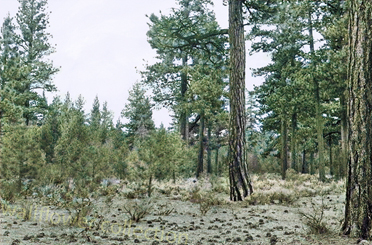
Holcomb Valley 1936 (colorized)
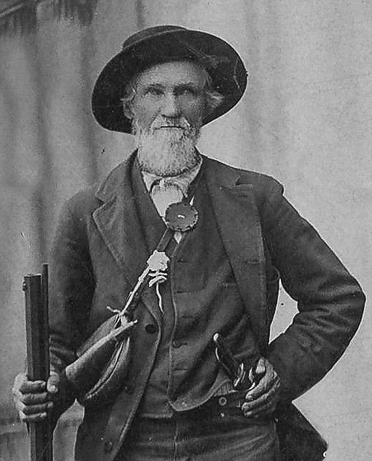
W. F. Holcomb
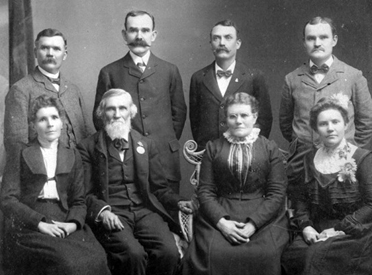
W. F. Holcomb Family
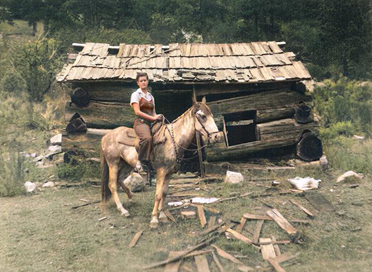
Belle Van Dusen (colorized)
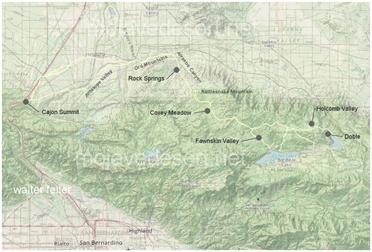
Van Dusen Road map
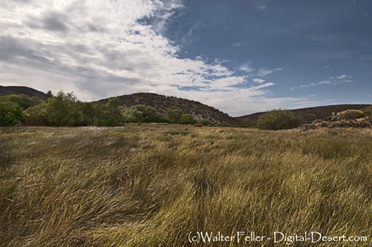
Coxey Meadow
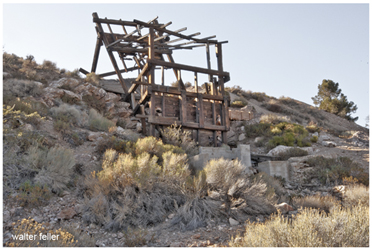
Gold Mountain Mill